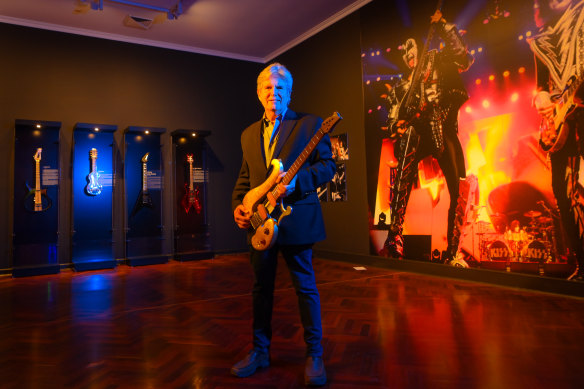Picasso, Manet, Renoir and … KISS? A show with a difference
By Will Cox
A new exhibition charts the global influence of one of the most popular instruments in the world.
Medieval To Metal: The Art & Evolution of the Guitar, which opens on Saturday at the Art Gallery of Ballarat, is co-curated by HP Newquist, a New York-based writer and executive director of the National Guitar Museum, a touring collection of instruments and paraphernalia.

HP Newquist at Medieval to Metal: The Art and Evolution of the Guitar in Ballarat.Credit: Justin McManus
On display are 40 rare instruments, from the oud, which dates to around 3000 BC, through to the 20th-century invention of the electric guitar, Newquist’s first love.
“The electronic guitar came out perfectly formed,” says Newquist. “One of the most recognisable silhouettes in the world is the Fender Stratocaster. People might not know the name, but they know it’s an electric guitar.”
In addition to Newquist’s pieces, co-curator (and the Art Gallery of Ballarat’s director) Louise Tegart has added around 265 works from the gallery’s own collection, and those of the NGV, NGA and other galleries and artists. Between the guitars you’ll find a pencil work by Pablo Picasso, and it’s possibly the first time work by 19th-century French artist Edouard Manet has been displayed this close to a huge photograph of the band KISS.
“For what other instrument do you bleed?”
HP Newquist
Album art, gig posters and rock photography are a given in a show like this. Less so are the perspective drawing by Albrecht Durer, dating to 1525, which shows a lute as a reference object, or The Guitar Player (La Joueuse de guitare), a c.1896 painting by Renoir, depicting a guitarist in her parlour. This one is a highlight for Tegart, showing as it does the story of the guitar beyond the masculine posturing it’s known for.
“We like to put old and new artworks in conversation,” says Tegart. “I wasn’t aware of any exhibition in Australia like it, and I thought it might strike a chord.”
So why, I ask Newquist, has the instrument not only endured, but acquired this level of cultural power?
“Four reasons,” he says. “It’s a very portable instrument. You can’t carry a piano. Secondly, it’s one of the only instruments where you can accompany yourself with vocals. Thirdly, it’s the only musical instrument you embrace while you play it. You feel the music in your abdomen, your chest cavity.”

B.C. Rich “Warlock” 1981, on display at the Art Gallery of Ballarat.Credit: Justin McManus
And the fourth?
“It’s the only instrument that hurts to play. When you learn on steel strings, you get blisters, and you bleed. You have to push through that. For what other instrument do you bleed?”
When he was in high school, Newquist wanted to be a rock star. He played in some college bands, and recorded some music, but nothing lasting. His career as a writer brought him back to music when he began contributing to, and eventually editing, Guitar magazine. When a visitor pointed out that his house looked like a guitar museum, he realised such a thing didn’t exist.
He’s now perpetually on the road with his 200-instrument collection. In a way, he is fulfilling the rock and roll touring dreams of his youth. He’s taken the collection to 58 locations in the US, and this year it made its first overseas appearance in Whirinaki Whare Taonga in Upper Hutt, New Zealand. Now, it’s in Ballarat.

Though guitar rock bands don’t dominate the pop charts as they once did, the instrument’s iron grip over pop culture shows no sign of abating.Credit: Justin McManus
Though the millennia-old history of the instrument is covered, the bulk of the show comes from the 20th century and beyond. And there’s a strong Australian angle to the art on show, including playful portraits of rock idols from Yankunytjatjara artist Kaylene Whiskey and Western Aranda artist Vincent Namatjira.
“Rarely do we have anything that goes so far across artistic genres as this,” says Newquist. “It reflects the whole nation’s culture. It really gives you a sense of not only the history of country, but how the guitar has been a part of that history.”
And much of the work is specifically Ballaratian.
“Ballarat has this amazing history of music,” says Tegart. “In the goldfields times, music was not only a way of crossing cultures, but a relief from the drudgery.”
Though guitar rock bands don’t dominate the pop charts as they once did, the instrument’s iron grip over pop culture shows no sign of abating. And a new generation is picking it up. Tegart cites a study undertaken by Fender in 2018 which found that 50 per cent of all beginner guitarists were women and girls.
“Its popularity goes in cycles,” says Newquist. “In the current cycle, you have performers like Taylor Swift, who plays the guitar on stage. She’s inspiring a new generation to play, in much the same way that Jimmy Page inspired me.”
Medieval to Metal is at the Art Gallery of Ballarat from October 12 until February 2, 2025.
The Booklist is a weekly newsletter for book lovers from Jason Steger. Get it delivered every Friday.